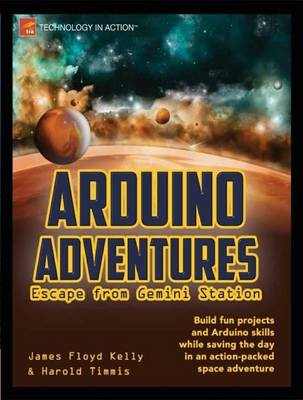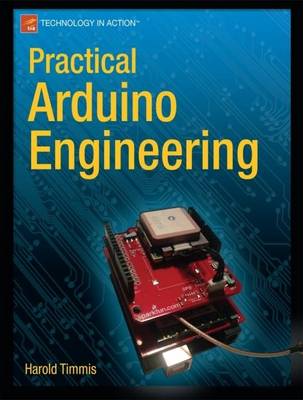Technology in Action
3 total works
Trouble ensues. The station is evacuated, including Cade and Elle's class that was visiting the station on a field trip. Cade and Elle don’t make it aboard their shuttle and are trapped on the station along with a friendly artificial intelligence named Andrew who wants to help them get off the damaged station. Using some old hardware, a laptop, and some toolboxes full of electronics parts, you will follow along and build eight gizmos with Cade and Elle that will help them escape from Gemini Station.
The hardware is Arduino. Each new challenge opens a new area of Arduino and basic electronics knowledge. You’ll be taken incrementally from a simple task such as turning on a light through to a complex combination of microcontroller, electronic components, and software programming. By the end of the book you’ll be well on your way towards being able to create and implement any sort of electronically controlled device you can imagine, using the stunningly popular Arduino microcontroller.
- Provides eight challenges, each challenge increasing in complexity
- Builds around a fictional storyline that keeps the learning fun
- Leaves you on a solid foundation of electronic skills and knowledge
Do you like to build things? Are you ever frustrated at having to compromise your designs to fit whatever parts happen to be available? Would you like to fabricate your own parts? Build Your Own CNC Machine is the book to get you started. CNC expert Patrick Hood-Daniel and best-selling author James Kelly team up to show you how to construct your very own CNC machine. Then they go on to show you how to use it, how to document your designs in computer-aided design (CAD) programs, and how to output your designs as specifications and tool paths that feed into the CNC machine, controlling it as it builds whatever parts your imagination can dream up.
Don't be intimidated by abbreviations like CNC and terms like computer-aided design. Patrick and James have chosen a CNC-machine design that is simple to fabricate. You need only basic woodworking skills and a budget of perhaps $500 to $1,000 to spend on the wood, a router, and various other parts that you'll need. With some patience and some follow-through, you'll soon be up and running with a really fun machine that'll unleash your creativity and turn your imagination into physical reality.
- The authors go on to show you how to test your machine, including configuring the software.
- Provides links for learning how to design and mill whatever you can dream up
- The perfect parent/child project that is also suitable for scouting groups, clubs, school shop classes, and other organizations that benefit from projects that foster skills development and teamwork
- No unusual tools needed beyond a circular saw and what you likely already have in your home toolbox
- Teaches you to design and mill your very own wooden and aluminum parts, toys, gadgets—whatever you can dream up
Arduino boards have impressed both hackers and professional engineers. Whether you're a hobbyist or a professional, it isn't just a breadboard and a hazy idea that keeps you going. It's essential to institute a proper design, device instrumentation and, indeed, test your project thoroughly before committing to a particular prototype.
Practical Arduino Engineering begins by outlining the engineering process, from the basic requirements and preliminary design to prototyping and testing. Each and every chapter exemplifies this process and demonstrates how you can profit from the implementation solid engineering principles—regardless of whether you just play in your basement or you want to publicize and sell your devices.
Arduino is a brilliant prototyping platform that allows users to test and iterate design ideas. Imitation by other Arduino makers, hackers and engineers often proves your design's popularity. Practical Arduino Engineering will teach you to follow the engineering process carefully; over time, you will be able to review and improve this process, and even extend its scope.
Practical Arduino Engineering is not purely theoretical. In addition, you'll learn the process of hardware engineering as applicable to Arduino projects, and the importance of the process in each and every project presented in this book.
To set the stage, Practical Arduino Engineering begins by reviewing the Arduino software landscape, then shows how to set up an Arduino project for testing. Even if you already know your compiler toolchain and the basics of Arduino programming, this refresher course can help fill in the gaps and explain why your compiler may spit out certain error messages.
Practical Arduino Engineering then gradually builds up the engineering process, from single devices like LCDs, potentiometers and GPS modules, to the integration of several modules into larger projects, such as a wireless temperature measurement system, and ultimately an entire robot.
The engineering projects become progressively more challenging throughout the first 4 engineering chapters. Next, you'll proceed with simple steps towards the first intelligent part of a robot: the object detector. You'll find yourself teaching your robot how to avoid very hot objects or insurmountable obstacles. The basic design requirements for a complete robot and, indeed, the detailed design and prototyping for robots can be extremely tricky, which is why engineering discipline is invaluable.
Practical Arduino Engineering then enters the world of domestic engineering by introducing home alarm systems—not quite as simple as they seem. A solid, robust system can only be built by following the engineering process detailed in previous chapters, and this section reinforces that process.
You'll then take a step further in your Arduino engineering process: instrumentation and control, and some error messaging using GSM. Control is introduced via the Xbox controller, a very powerful piece of technology able to play a considerable role in robotics projects. Having already learned to control motion and to sense and avoid objects, you'll learn how to debug your Arduino projects of varying complexities via the hardware instrumentation software LabVIEW.
To complete the journey into Practical Arduino Engineering, you'll discover how to use a special Arduino board to rely on Bluetooth Mate Silver for control of domestic and mobile Arduino projects. Using Bluetooth Mate Silver, you'll learn to implement basic engineering design with almost any Arduino project, and be able to justify, build, debug, and extend Arduino-based designs using a solid engineering approach.
Please note: the print version of this title is black & white; the eBook is full color.


